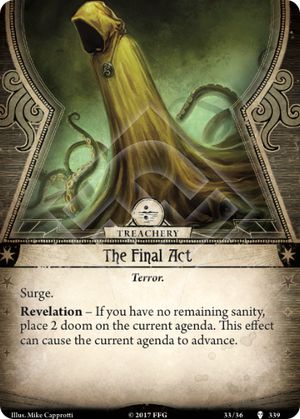In my opinion, this card shows a problem Fantasy Flight Games has with some of their games, namely Arkham Horror and The Lord of the Rings. In both games, a fairly frequent occurrence is scenarios where there's a binary state; either the players are in state A, or they're in state B. For Dim Carcosa, that binary state is "No sanity remaining;" either you have sanity remaining, or you don't. This in and of itself is not a problem, but the way FFG makes the scenario use the state is.
In any state-based scenario, there are a few questions to consider;
- Which state will the players want to be in, absent any non-act or agenda features?
- Which state is easier to stay in and how much effort is required to change states?
- Do the designers want to incentivize or discourage being in either of the states?
For Dim Carcosa, the answers are relatively simple:
- All the players' experience will incentivize them to make sure they have sanity remaining.
- It is easier to have no sanity remaining, and while it's easy to go from sanity to no sanity, it's very hard to do the reverse without cards dedicated to the task.
- Not known for certain, but my guess is that they wanted to discourage having no sanity remaining, in order to make use of the design space the mechanic of sanity in Carcosa opened up, to emphasize the dangers of Carcosa, and to prevent infinite sanity from trivializing the game.
These answers help us to better understand the design of a lot of the cards in the scenario; Dismal Curse helps turn the horror on players into damage, Realm of Madness tears the player's board state to shreds if they have no remaining sanity, and The Final Act serves as 2 Ancient Evils and another encounter card if they have no remaining sanity. All of these serve the goal of discouraging players from running out of sanity, and do so admirably.
What's done less admirably in the scenario, in my opinion, is discouraging players from keeping their sanity. State B is heavily punished, but State A feels barely touched, and the scenario honestly feels like it doesn't push losing your sanity (Going from State A to State B) on you too heavily, the way The Forgotten Age might push the Poisoned weakness, for example. Yes, there's Rotting Remains and The Yellow Sign, but even on top of the starting horror you take, it feels like being pushed over the boundary between the two states is gradual, honestly downright avoidable at times.
Once you are over that line, though, suddenly you have to deal with double Ancient Evils (with surge), a 3-of 5 test in the encounter deck, the potential to be flat out killed before you have the chance to react, and a chaos bag that, on Normal, went from five -2 tokens to four -4s. Add in Hastur's nightmarish mutation of the chaos bag, and you've gone from potential victory to almost-certain defeat. Your friends who still have sanity, meanwhile, are still able to traverse the land of the King, possibly without abnormal threat if they're able to shrug off The Yellow Sign and Rotting Remains.
This is the problem FFG has with binary-state scenarios: they make one state too punishing without including enough that forces the player into that state. You live or die based on which state you're in, and it's surprisingly hard for the game to push you into one.
Fortunately, this is somewhat easily fixable; instead of including so many cards that punish players for being in "the bad state," include a mixture of cards that alternate between punishing the players for being in "the bad state" and pushing the players towards that state, designing an encounter deck that not only tries to keep players down but also has methods of getting them there in the first place. For Dim Carcosa, that might have meant making Dismal Curse push the players towards losing their sanity instead of punishing them for not having any, or making Hastur's frankly game-ending token manipulation apply if you have sanity remaining, incentivizing you to fall deeper under the King's sway. The twin suns of Carcosa might be searing madness into the investigator's minds (personally, I think a lot of the visuals from this cycle would actually look beautiful in real life), but that doesn't mean the designers don't have the tools of reason to help them keep that madness from plaguing their players as well.
